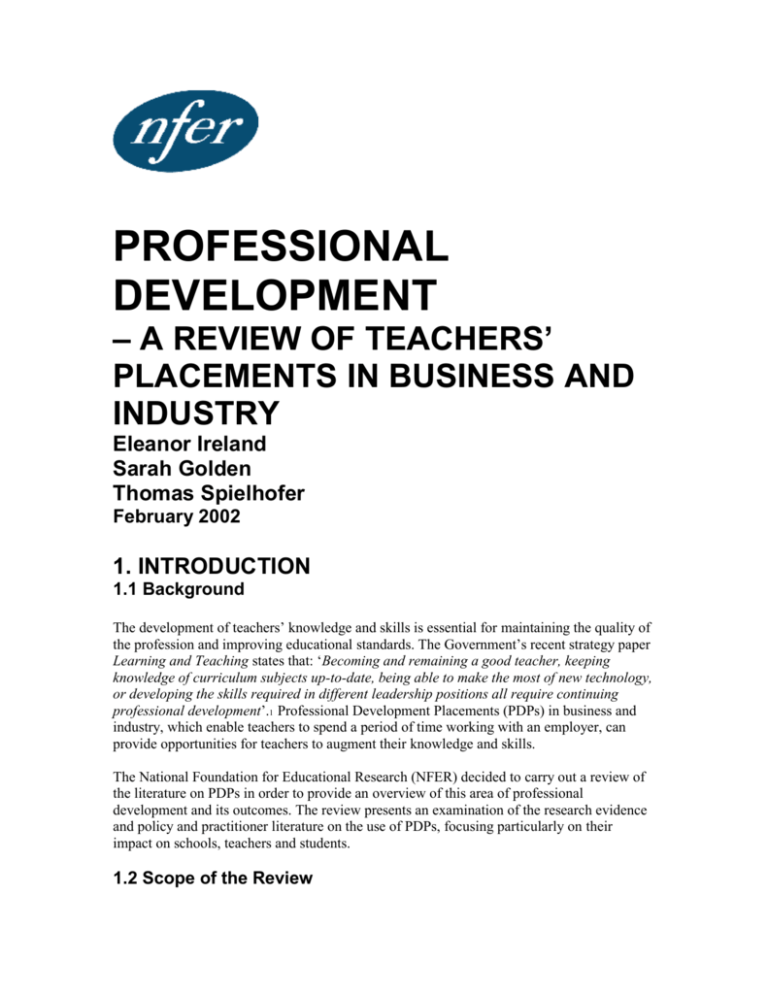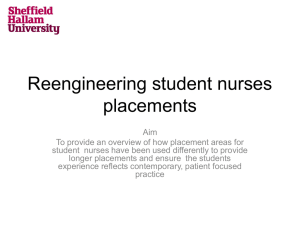PROFESSIONAL DEVELOPMENT
advertisement

PROFESSIONAL DEVELOPMENT – A REVIEW OF TEACHERS’ PLACEMENTS IN BUSINESS AND INDUSTRY Eleanor Ireland Sarah Golden Thomas Spielhofer February 2002 1. INTRODUCTION 1.1 Background The development of teachers’ knowledge and skills is essential for maintaining the quality of the profession and improving educational standards. The Government’s recent strategy paper Learning and Teaching states that: ‘Becoming and remaining a good teacher, keeping knowledge of curriculum subjects up-to-date, being able to make the most of new technology, or developing the skills required in different leadership positions all require continuing professional development’.1 Professional Development Placements (PDPs) in business and industry, which enable teachers to spend a period of time working with an employer, can provide opportunities for teachers to augment their knowledge and skills. The National Foundation for Educational Research (NFER) decided to carry out a review of the literature on PDPs in order to provide an overview of this area of professional development and its outcomes. The review presents an examination of the research evidence and policy and practitioner literature on the use of PDPs, focusing particularly on their impact on schools, teachers and students. 1.2 Scope of the Review The aim of the review, which was undertaken in 2001, was to scrutinise the available literature in order to: gather evidence on the process and practice of PDPs; investigate the outcomes and impact of PDPs for teachers, students, schools and employers; identify the key considerations in the effective use of PDPs. This review provides details of: the evidence available and definitions of PDPs; the developments in the organisation of PDPs; the impact and outcomes of PDPs on: o teachers o schools o students o employers challenges in planning and implementing PDPs; foundations of good practice; recommendations for further research. 2. EVIDENCE AND DEFINITIONS 2.1 Evidence Available This review focused on literature on PDPs in the UK and drew ondocuments from other countries as appropriate. The majority of theliterature available was descriptive, explaining what PDPs in businessand industry are and how they are organised. Much of this literaturecontained anecdotal evidence provided by a teacher or several teacherswho had undertaken a placement. The rest of the literature comprisedpolicy documents, statistical information and guidelines on theorganisation of placements. It should be noted that there was a paucityof research-based studies and evidence on the outcomes of PDPs. 2.2 Defining PDPs The main characteristics of PDPs identified in the literature are presented below: o o o o o PDPs take place in a wide range of industry and commerce and in the public and voluntary sectors. The majority of the placements reviewed were in the leisure and tourism, finance, manufacturing and retail sectors. The length of the placements ranged from one day to over one year, but the majority were five days or fewer. These were generally undertaken in block but were occasionally spread over a period of weeks. Placements recounted in the literature were undertaken mainly by secondary school subject teachers and senior teachers. Placements for primary teachers were reported less frequently. Placements were most often undertaken by science and technology teachers and teachers of vocational courses and least frequently by teachers of arts subjects. The majority of the placements described in the literature were undertaken in the teachers’ local areas. However, there were some international placements in the United States (US) and some organised through Comenius2 to Europe. 3. DEVELOPMENTS IN THE ORGANISATION OF PLACEMENTS Responsibility for teacher placements, which previously lay with the Teacher Placement Service, now lies with the Learning and Skills Council (LSC). In 1999, the Government’s Learning to Succeed 3 White Paper set out the main responsibilities of the new LSC, which included ‘ensuring an effective Education Business Partnership network exists to support the delivery of work-related learning’.4 To support the LSC in ensuring such a network exists, an Education Business Link Organisation (EBLO) consortium was established in each area, whose role is to coordinate education–business activity and to provide one point of contact for the LSC. Funding for education–business links comes from the Government through the local LSCs to the EBLO consortia. These consortia comprise the main local organisations that have a role in facilitating education–business links, such as SETPOINTS (previously known as Science and Technology Regional Organisations (SATROs)), Young Enterprise, Trident, and Education Business Partnerships (EBPs). Whilst any of these organisations could arrange teacher placements, they are most commonly organised through EBPs. Placements are also organised by other organisations principally Heads, Teachers and Industry (HTI), an educational charity which arranges placements for senior teachers in management positions in leading UK companies, and Industry and Enterprise Awareness for Teachers and Schools (IEATS) within Scotland. Recently, teacher placements were renamed Professional Development Placements (PDPs). One interpretation of this is that that placements are considered to be less as one-off events and more as making a contribution to the continuing development of teachers’ knowledge and skills. The extent to which this occurs is explored in the next section. 4. IMPACTS AND OUTCOMES 4.1 Teachers The majority of the literature indicated that PDPs were most successful for the teacher when they were seen as part of the teacher’s continuing professional development and had the full support of the school’s senior management team before, during and after the placement. The main reported gains were as follows: o o o o Increased confidence, motivation and self-esteem were some of the most widely reported benefits of PDPs. Placements gave many teachers confidence in their own abilities, which, in turn, led to an increase in motivation and self-esteem.5 Increased technical knowledge was an outcome of placements taken particularly by science and ICT teachers at key stages 3 and 4.6 Development of teaching materials/resources was reported as an outcome of placements for many teachers on short placements and was one of the predominant benefits for primary school teachers. Placements for groups of teachers were also described as useful for exchanging teaching ideas and making contacts. For example, teachers who took part in a group placement at a theatre company were able to share their experience and developed new approaches to teaching Shakespeare.7 ‘Hands-on’ experience of a particular industry was reported as particularly valuable for teachers of vocational subjects.8 o Management and leadership skills were gained during longer placements by senior teachers, especially those organised by HTI. Less senior teachers also benefited from placements by improving their leadership skills, thus contributing to their continuing professional development.9 4.2 Schools Much of the literature advocated that PDPs should be supported by the school’s senior management team and incorporated into the School Development Plan in order to maximise benefits for the school. Benefits to the schools included the following. o o o o Dissemination to all teachers of new skills learned in the placement. However, this required time and management support for the implementation of post-placement action plans. Creation of a school–business relationship resulted from many placements, where efforts were made to maintain contact with employers after the placement. It was reported that ongoing school–business links can facilitate work experience placements for students, future PDPs for teachers, reciprocal visits from businesses and mock interviews for students.10 New management techniques were implemented in schools with the support of the senior management team as a result of some placements, most commonly where placements were undertaken by senior teachers. These techniques related to the management of change, marketing, team building and financial forecasting.11 4.3 Students The main benefits identified for students were as follows: o Improved teaching materials/resources were reported in much of the literature to be beneficial to students. In some instances, material gathered during placements helped to link what sometimes appear to be only abstract subjects to the ‘real world’, for example placements within the construction industry allowed maths teachers to use geometry to solve real problems faced in construction.12 o Improved teaching was another outcome noted by teachers. Much of the literature remarked that after the placement, the teacher returned to school with more enthusiasm, new ideas and an improved technical knowledge. 13 o Accurate careers information about recruitment, training and specialised knowledge in a specific sector was cited as increasingly available to students as a result of PDPs for teachers. An ongoing link with a company as a result of a placement often ensured future visits and work experience placements for students.14 4.4 Employers The literature reported that effectively planned placements could be directly positive to businesses. The main benefits identified included: o Cost-effective staff development through, for example, improvements in the development of coaching and mentoring skills among staff gained from working with teachers. This contributed to employees’ continuing development and improved staff morale.15 o o o o Cost-effective consultancy. In longer, more participatory placements, teachers were able to carry out projects and consultancy work which the company might otherwise have had to buy in.16 Many employers appreciated the independent perspectives that teachers on placements were able to bring to the company.17 New management skills. Businesses could learn and benefit from the management skills of senior managers from schools.18 Improving the image of the business in the community was seen as a benefit to employers, which may lead to a boost in sales and improved public relations, and raised the profile of the business as an employer in the local area.19 Opportunities to influence education in the long term by contributing to local education, and, as a consequence, improving the calibre of potential future employees,20 were also noted as potential outcomes for businesses. 5. CHALLENGES The review identified several challenges regarding the planning and implementation of PDPs. The most common challenges are outlined below. o o o o o o Length of the placements. Longer placements were generally seen as more effective than shorter ones, although some authors suggested that well-organised short placements could be equally as effective as longer ones. The literature indicated that in planning the length of placement, the aims and purpose of the placement should be taken into consideration. For example, some short placements (one to ten days) were described as too short for curriculum development or highly participatory placements, and too long for extended tours of the company and work shadowing.21 Timing of the placements. Disruption to teaching and the cost of supply cover were two problems associated with placements undertaken during term time. Not surprisingly, perhaps, some teachers were reluctant to give up their holidays in order to go on placements.22 Re-entry problems after long placements. It was reported that some teachers became unsettled after long placements and were uncertain about returning to school. In other cases, teachers found re-entry difficult, as colleagues did not recognise that they had changed, and were not receptive to new ideas.23 Implementing change after the placement. Many post-placement reports noted teachers’ frustration at not being able to use the skills they had learned during the placement due to a lack of senior management support or time restrictions. This suggests that a balance needs to be found between the expectations of the teacher and the expectations of the school’s senior management concerning the purpose and outcomes of the placement.24 Lack of time or commitment from employers was a challenge encountered by some teachers. This occurred generally in less participatory placements, where the employer saw the placement as a one-way altruistic experience rather than beneficial to both parties.25 Placements may lead teachers to reconsider their profession. In the literature, there were a few instances where the teacher did not return to the school after the placement but decided to retrain or pursue a different career. Some authors observed that the experience of an alternative role or work place conditions may lead teachers to reconsider their career in teaching.26 6. FOUNDATIONS OF GOOD PRACTICE The literature contained many guidelines for teachers, schools and employers which related to best practice in the organisation of PDPs. The most salient of these are summarised below. o o o o Support of the senior management team and incorporation of the placement into the School Development Plan and the teacher’s continuing professional development plan were recommended by much of the literature in order to gain maximum, long-term benefits from the placement across the school. 27 Specific, defined, realistic, negotiable objectives based on clearly identified staff development needs.28 Employers and teachers recommended that in order to gain maximum benefit from the placement, both parties should meet prior to the placement to agree upon achievable objectives for both the teacher and the employer. Much of the literature also suggested that there should be a meeting during the session to discuss the progress they have made in reaching these objectives, as well as a debriefing session after the placement to discuss the placement and future action plans.29 Careful matching of the teacher and the employer. It should be ensured that both the employer and the teacher have the skills and the commitment necessary to achieve their objectives – this is theresponsibility of the teacher, employer and organisation through which the placement is arranged.30 Emphasis of benefits to business. Education–business organisations must ensure that local businesses are aware of the many immediate benefits that placements can have for them in order to encourage participation in, and the success of, placements. 31 7. EMERGING OBSERVATIONS The literature reviewed indicated that PDPs have been beneficial to teachers, schools, students and businesses. In addition, one key indirect benefit of involvement in PDPs was the creation of a school–business relationship which can have wider long-term benefits for both parties. The literature emphasised that the success of PDPs is dependent upon several factors, including: o the commitment of all those involved; o the thorough planning and preparation by teachers, schools and businesses; o a close match between the expectations of teachers and businesses; o the involvement and commitment of senior management in the school. o Overall, this evidence indicates that the benefits of placements have to be balanced against the financial costs and time constraints on the school and the business. This review has found that although there is considerable literature on PDPs, there is a lack of recent, robust, research-based evidence on PDPs. This suggests that there could be scope for exploring the use of PDPs further through: o o o an independent assessment of the organisation and management of PDPs; research into the value-added by PDPs to schools and businesses, from the viewpoint of the senior management; research into the optimum length of placements and the level of support necessary in order to balance the outcomes achieved and the costs incurred; o a study of the impact of PDPs on the classroom practice of teachers, and consequently on the learning of their students, and the factors which influence this; an international study of the different uses and outcomes of PDPs. o o Literature search strategy: A number of databases were searched by the NFER library staff, including ASSIA, ChildData, British Education Index, ERIC, CERUK, PsycInfo Australian Education Index, CBCA full text, BOPCAS. On the Internet, Blaise Web was searched focusing particularly on BNB and SIGLE. BookBank was searched in order to identify books on the subject. Around 100 documents were reviewed. A full bibliography and methodology for the review can be found online at: www.nfer.ac.uk/research/down_pub.asp REFERENCES DEPARTMENT FOR EDUCATION AND EMPLOYMENT (2001). Learning and Teaching: a Strategy for Professional Development (DfEE 0071/2001). London: DfEE [online]. http://www.teachernet.gov.uk/bank/A0210_CPD_Strategy.pdf [24 January, 2002]. 2 COMENIUS (2001). European Cooperation on School Education: Activities Supported under COMENIUS [online]. Available: htttp:// europa.eu.int/comm/education/socrates/comenius/acttypes.htm [14 December, 2001]. 3 GREAT BRITAIN. PARLIAMENT. HOUSE OF COMMONS (1999). Learning to Succeed: a New Framework for Post-16 Learning (Cm. 4392). London: The Stationery Office. 4 Ibid. 5 FINN, W. (1992). ‘Teacher placements: education and business perspectives’, Education + Training, 34, 4, 26–30. FOCUS CENTRAL LONDON TRAINING AND ENTERPRISE COUNCIL (1999). The FOCUS Central London Teacher Bursary Placement Scheme. London: FOCUS Central London TEC. 6 BROWN, S. and CHALMERS, V. (1990). Teacher Placements in Industry: Gaining Maximum Benefits (Spotlight 18). Edinburgh: SCRE. FOCUS CENTRAL LONDON TRAINING AND ENTERPRISE COUNCIL, op. cit. 7 BLOWN, A., FERGUSON, A., HYDE, T. and MCLARDY, J. (n.d.) Building Links. Edinburgh: Lothian Education Business Partnership. FOCUS CENTRAL LONDON TRAINING AND ENTERPRISE COUNCIL, op. cit. 8 Ibid. 9 MAUDE, T. (2001). ‘Key skills – a new model for teacher placements in business’, Headway, Summer, 3. 10 ANDERSON, J. (1991). ‘Curriculum and management development opportunities for the pastoral team’, Pastoral Care in Education, 9, 1, 20–2. 11 HEBDITCH, G. (1995). Headteachers Into Industry 1986–1995. Warwick: HTI Ltd. 12 BLOWN, A., FERGUSON, A., HYDE, T. and MCLARDY, J., op. cit. 13 FRY, K. (1993). ‘Economic awareness for primary teachers and children: experiences in Sussex’, Education, 21, 1, 8–10. 14 BLUM, P. (1989). ‘Five days on the outside’, Report, 11, 5, 8–9. CENTRE FOR EDUCATIONAL RESEARCH AND INNOVATION (1992) Schools and Business: a New Partnership. Paris: OECD. 15 FENDLEY, A.E. and HARRIS, N.D. (1989). ‘The business/industry placement scheme for teachers’, International Journal of Educational Management, 3, 2, 27–32. CENTRE FOR EDUCATIONAL RESEARCH AND INNOVATION, op. cit. 16 FENDLEY, A.E. and HARRIS, N.D., op. cit. 17 HAIGH, G. (1997). ‘Pearls of wisdom’, Times Educ. Suppl., 4213, 28 March, 19. 1 HASTINGS, S. (2001). ‘From chore to challenge’ (TES Friday), Times Educ. Suppl., 4428, 11 May, 25. 19 FENDLEY, A.E. and HARRIS, N.D., op. cit. 20 Ibid. 21 BROWN, S. and CHALMERS, V., op. cit. 22 GORMAN, G. (1989) School–Industry Links. London: Kogan Page, pp.105–11. 23 FOCUS CENTRAL LONDON TRAINING AND ENTERPRISE COUNCIL, op. cit. 24 COLES, M. (2000). ‘Lessons at the university of life’, London Evening Standard, 30 October, 15. 25 BROADHURST, L. (1991). ‘An industrial secondment’, Modus, April, 91–2. 26 BLUM, P., op. cit. 27 BROWN, S. and CHALMERS, V., op. cit. 28 WILSON, V., PIRRIE, A. and McFALL, E. (1996). Progress in Partnership: Evaluation of Education Business Links and Teacher Placements. Edinburgh: SCRE. BROWN, S. and CHALMERS, V., op. cit. 29 GORMAN, G., op. cit. 30 BLACKLEDGE, R. and LAWSON, S. (1991). European Partnerships Through Work Experience and Work Shadowing. London: Industrial Society Press. 31 Ibid. 18 © National Foundation for Educational Research 2002 A complete list of NFER publications can be found on the NFER website at: www.nfer.ac.uk If you wish to purchase or find out more information about any NFER publication, contact Book Sales: Tel: (01753) 747281 Fax: (01753) 747193 email: book.sales@nfer.ac.uk Research summaries are also on the NFER website at: www.nfer.ac.uk/research/project_summaries.asp








